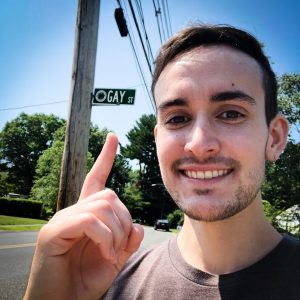Sustainable Fishing – A Case Study of Cooperation
We are really good at catching fishing. While the number of fish being commercially caught is ranges from 4-55%, the fact-of-the-matter is that overfishing is an issue in need of attention. The answer isn’t simply that less fishing needs to occur, it is much more nuanced than that – Is there a way to have more fish and seafood, provide jobs for those in the fishing industry, and make the oceans healthier? Sustainable fishing practices seek to manage this issue, but how are those practices informed? Responsible resource management is just one example of how not cooperating (overfishing) will deplete our resources. What do we know about cooperation? Can we quantify the tipping point?

Cheaters Never Prosper, Or Do They?
This week’s guest, Bryan Lynn, a second-year PhD student co-advised by Dr. Patrick De Leenheer in the Department of Integrative Biology and Martin Schuster in Microbiology studies the evolution of cooperation. To do this, Bryan scales his work way down to microorganism level. Evolutionary theory has been largely based on the Darwinian premise of the survival of the fittest, but Bryan’s research is challenging this – not cooperating makes you more fit as an individual, but is that best for the group as a whole?

Using the bacteria Psuedomonas aeruginosa as a model organism, Bryan is able to manipulate the behavior of the bacteria and study what happens in a chemostat system – a device which allows the bacteria to grow continuously with a constant input of a food source and output of the mixed solution – making it an excellent metaphor for life. When there are finite resources available, questions can be asked about how the bacteria cooperate with each other in different scenarios. For example, Bryan mutates some of the bacteria to be so-called “cheaters,” as they do not make an enzyme and thus do not expend energy but reap all the benefits as the non-cheater bacteria. Using mathematical models, Bryan is able to simulate different conditions and put a number to the tipping point where the community is no longer able to persist in a steady state.

The Path to Math
Bryan spent many years as a Le Cordon Bleu-trained pastry chef before deciding he wanted to change careers and find something with better pay and benefits. Bryan returned to community college in Minnesota and started taking math courses, as they were a relevant start to any STEM field should he decide to switch majors, but he never did. Bryan eventually transitioned to the University of Massachusetts in Boston where he earned his bachelor’s degree in math.
As an undergraduate Bryan took courses in evolutionary game theory, which allowed him to find a way to bridge math theory to a real-world application. During his time in Boston, Bryan also had the opportunity to intern at the MIT Bates Radiation Facility to study proton lasers used for cancer treatments, as well as complete an Oracle Fellowship where he began a research project investigating the evolution of cooperation through ostracism. This research opened up Bryan to world of math biology, which ultimately led him to pursue a PhD at Oregon State. After graduate school Bryan hopes to continue research in academia and provide representation for the LGBT+ in STEM fields.
Join us on Sunday, November 17 at 7 PM on KBVR Corvallis 88.7 FM or stream live to learn more about Bryan’s math biology research, non-traditional journey to graduate school, and LGBT+ activism.
To learn more about Bryan’s research, check out his publication:
https://www.sciencedirect.com/science/article/abs/pii/S0025556419303785?

































